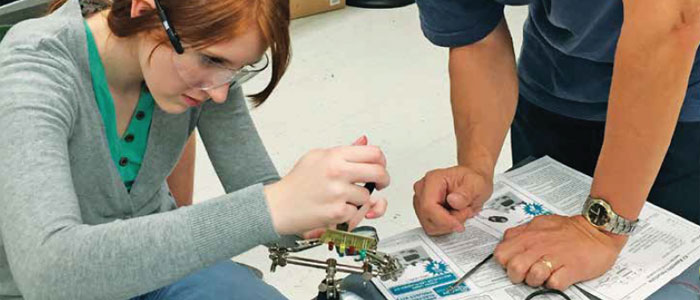
In response to what some are calling a “STEM crisis,” or the shortage of young people pursuing degrees in science, technology, engineering and math in college, companies, both locally and nationally, are turning to school robotics programs to spark an interest in these fields of study. Shan Cooper, vice president and general manager at Lockheed Martin Aeronautics Company in Marietta, says it takes time to grow leaders in STEM careers, and as a nation, the United States is falling behind, which puts technical leadership roles at risk. “For instance, almost half of the Lockheed Martin employees around the world are engineers or have critical STEM skills, and about half of our employees are eligible for retirement over the next five years,” Cooper says. “This means we are facing a serious shortage of qualified people with STEM educations and skills to keep us competitive in the world market.”
According to the U.S. Department of Education, only 16 percent of American high school seniors are proficient in mathematics and interested in a STEM career—and only half of those ever pursue a career in this area. And Cooper says this is not just a concern they have at Lockheed. “Competition for qualified STEM-educated talent will be intense across all business sectors—manufacturing, cyber, defense industries and many more,” Cooper adds. “Our colleagues in the business community all worry about this issue. It directly affects us all as we face the prospect of diminishing STEM skills in the workforce. So I encourage—and challenge—all business leaders to help us build tomorrow’s workforce, strengthen our nation’s technological advantage and help create a constant supply of highly trained, highly capable technical talent.”
Stepping Up to the Challenge
In addition to Lockheed, companies like Novelis, General Electric, Cobb EMC, UPS, The Coca-Cola Company, Georgia Aquarium and Kennesaw State University, just to name a few, have partnered with local schools to support STEM-related programs. Specifically, Novelis has supported Kell and Walton high school’s programs for three years—both are close to the company’s Global Research & Technology Center in Kennesaw. “Novelis has been so impressed with the achievements and future potential of the young individuals comprising these two teams,” says Jack Clark, senior vice president and chief technical officer at Novelis, adding that they believe their partnership could inspire the next generation of engineers, scientists and technologists. “Who knows?” he asks. “We might have a few of the students we mentor currently on Novelis teams who end up joining our talented workforce one day.”
Novelis provides funding for the FIRST (For Inspiration and Recognition of Science and Technology) teams, which helps students pay for registration and travel fees for their competitions year-round, and their employees give their personal time helping students build robots. FIRST is an international youth organization that operates the FIRST Robotics Competition, FIRST Lego League, Jr. FIRST Lego League and FIRST Tech Challenge. Nationally, there are about 37,000 FIRST teams, including several here in Cobb, and the ages of student participants ranges from kindergarten to 12th grade. “Programs like FIRST are really adept at developing the leaders of tomorrow within our community,” Clark says. “Contributing time, talent and funding to FIRST is a smart investment for any business wishing to secure its talent base for years to come.”
GE supports programs at Wheeler, Kell, Walton, McEachern, Pope and Lassiter high schools, as well as teams at Dodgen, Dickerson, Mabry, Daniell and Simpson middle school and at Bells Ferry Chalker and Sedalia Park elementary schools. The international company provides mentors, sponsorship and opportunities for students to visit GE to share their experiences and learn a little about the company. Nearly 20 GE mentors are involved in robotics, providing more than 2,000 hours of mentoring annually, by way of engineering guidance, as well as help with the design process, outreach activities and coaching students to be more effective leaders.
Eric Kauffman, software product manager with GE, says their partnership began in 2008. “GE has long recognized the shortage of engineers in the future,” he says. “Mentoring and sponsoring is also a great way for GE and its employees to give back and support the local communities in which we work and live.” He adds that it also connects area students to GE. For example, a recent Walton graduate will do his internship at GE’s aviation business in Cincinnati this summer. “It is very rare for a student to get an internship after only their freshman year, but GE specifically made the exception because of the student’s involvement in FIRST,” says Kauffman, adding that increasing support for programs like FIRST is a great way to build the future pipeline of the country’s engineers.
Developing an Interest
One of the oldest FIRST programs in Cobb, and one that’s won several national awards, is Kell Robotics. The team is now independent of the school but was founded a little more than a decade ago as a club and includes students from a number of area high schools. Ed Barker, assistant director of Advanced Computer Services at KSU, joined the team as its director shortly thereafter. He personally believes that FIRST is one of the most powerful informal ways to educate young people about STEM. “We have to come up with a model for STEM activities, where the students can try things out in the informal space; and they have the time and room, whether it’s in science or robotics,” Barker says. “Once they try that out, they develop an interest and build their confidence, and confidence is crucial for many students in making a good career choice.”
Like many robotics programs countywide, Kell’s team is funded by dozens of private businesses, but Barker encourages school districts and the state department to invest more in programs like these. “Get behind the teachers, support the funding mechanism,” he advises. “We need these informal learning opportunities … There’s close to zero support from the school systems and that has to get fixed. Why? Because there is a financial burden, but they also haven’t discovered how important this is.” He went on to say that teachers, like athletic coaches, should be paid extra to teach clubs or programs after or during school. “If you want to get economic development going in this state and you want to create a lot of jobs, we have to get that done,” he explains.
A testament that students and the community are interested in STEM was clear at last year’s FIRST Atlanta Science Festival, which was attended by about 30,000 people. “There’s plenty of evidence floating around that says that if these students have the opportunities to try these things out … that large pools of students are academically qualified for a STEM career today, we just don’t harvest them,” Barker says. “There’s a connection between engineering and health care, national security, energy, public safety, many things … many good things in life come out of engineering and if we don’t support that, we are going to be in a world of hurt. There are a lot of issues to solve, so we have to communicate to the public why engineering is important.”
Other Successful Programs
Started by Walton’s engineering teacher and current team coach, Brian Benton, the Walton Robotics Team was founded in 2008. Senior Rishi Raj is one of 39 members on this year’s team. “The overall goal of our team and FIRST is to spread recognition of the importance of STEM and prepare our students for a future in STEM,” he says. “The country needs more people in STEM to meet its needs. This starts with programs like our team. Our team also aims to increase the number of girls interested in joining the STEM workforce as well.”
In their continued efforts to show others the significance of STEM, Walton’s team participates in nearly 50 outreach events annually to promote it in his community. Raj’s team has also been awarded for their designs and builds, winning the most prestigious award in FIRST, the Chairman’s Award, twice in 2013 and 2014, in addition to qualifying for the World Championships for four years in a row.
Thomas Cooper, technology integration specialist and upper school technology department chair at The Walker School, a private pre-K3 through 12th-grade school in Marietta, started Walker School Robotics six years ago. “I believe that computational thinking, programming and robotics give students the opportunity to do more critical thinking than traditional technology fluency courses,” he says. “Animatronics gives students the opportunity to also incorporate principles of art and design into their electrical engineering and programming projects.”
In the past three years, Walker has added a full-year class in the upper school and various class units in each grade starting in preschool. The school has also hosted a regional tournament each January to support VEX, a robotics competition program similar to FIRST, and STEM. Previously, Walker has won many regional competitions in Georgia, made it to the VEX World Championships and placed in the first VEX state competitions.
One of the newest FIRST robotics teams in Cobb was formed at Pope High in 2013, although there had been teams in Pope’s feeder middle and elementary schools. “This was seen by students, parents and the community as a distinct gap that needed to be filled,” says Jeff Cobb, Pope’s program director. After getting the green light from the administration and staff, who were enthusiastic about the addition, Cobb says they are now serving nearly 30 students. “During our rookie year’s regional competition, we were honored with the Gracious Professionalism award for demonstrating the guiding principles of the program,” he says. “This year, we won the Outreach Award for promoting STEM and recruiting new members.”
Jeff Cobb, who has worked in telecommunications for more than three decades and has seen first-hand the incredible advances in technology that allows programs like FIRST, adds that the allure of this program for him has been to help students develop well-rounded, practical experience in STEM, business, marketing and community service. “It helps them to experience and evaluate STEM as a viable future, and gives them an appreciation of how technology shapes our future,” he concludes. “Too often, children take today’s technology for granted, not recognizing how much farther we can go, and that they can be a part of those advancements.”
















